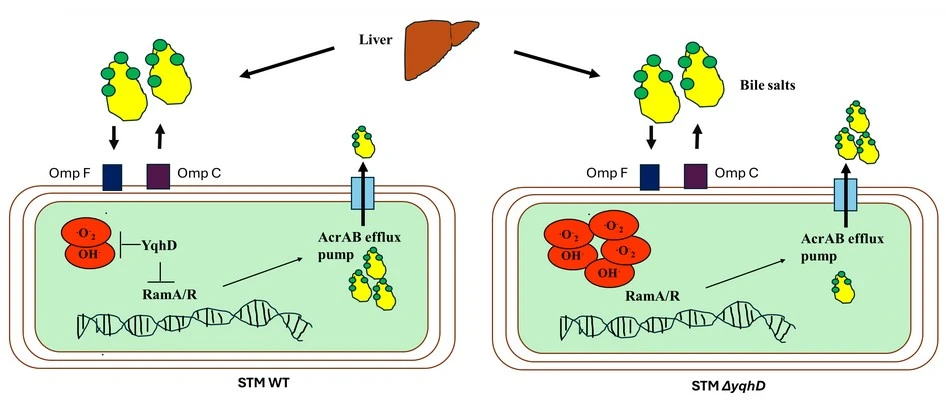Research Summary: Our findings show that yqhD in Salmonella leads to reduced survival on bile salt exposure by suppressing the AcrAB efflux pump activity, a key defence mechanism of bacteria.

Author interview
Kirti Parmar is a PhD researcher in microbiology at IISc studying host-pathogen interactions with foodborne pathogen Salmonella, uncovering mechanisms that make it a successful pathogen.
Linkedin: https://www.linkedin.com/in/kirti-parmar-00224a154/
Twitter: @KirtiPa21603835
Lab: Prof. Dipshikha Chakravortty, Indian Institute of Science, Bangalore.
Lab social media: @DipaLab_IISc
What was the core problem you aimed to solve with this research?
Bile is physiologically produced to aid in fat digestion; it is also antimicrobial in nature, reducing the pathogen burden in the intestine. However, bacteria like Salmonella have developed strategies to counteract its effect. The core problem we aimed to address was to identify the role of the antioxidant gene yqhD for Salmonella growth and survival on bile salts.

How did you go about solving this problem?
To solve this problem, we generated a mutant strain by deleting the yqhD gene in both Salmonella Typhimurium and Salmonella Typhi. We exposed it to primary and secondary bile salt mixture or infected hepatocyte cell line HepG2 to determine their susceptibility In-vitro and in C57BL/6 mice. To make this model physiologically relevant, we also fed mice a high-fat diet, as bile is produced during the digestion of fatty foods. Our results revealed that deletion of yqhD conferred a survival advantage to Salmonella. We further analysed the role of oxidative stress and other bile-responsive genes in the enhanced survival using q-RT-PCR. We found that AcrAB was upregulated in the mutant strain, and to confirm this, we inhibited AcrAB efflux pump activity.
How would you explain your research outcomes (Key findings) to the non-scientific community?
Imagine tiny pumps on the surface of Salmonella throwing out these toxic substances, such as bile and antibiotics. We discovered a gene, yqhD, which surprisingly works by slowing down these protective pumps, making the bacteria more vulnerable. When we removed that gene, the pumps functioned much better, removing more bile and helping the bacteria to survive longer.
YqhD is an antioxidant protein which when deleted, enables the Salmonella to survive better under bile stress. It probably opens up future avenues to investigate whether the persons who are carriers of Salmonella like Mary Mallon, actually have a mutation in yqhD gene. This deviated population must be surviving better in gall bladder encountering bile exposure. — Prof. Dipshikha Chakravortty
What are the potential implications of your findings for the field and society?
The burden of Salmonella is substantial in developing countries like ours, primarily due to inadequate sanitation and hygiene. Salmonella can survive in bile-rich environments, such as the gallbladder, and form biofilms, which can lead to long-term carriage in patients. This contributes to the increased transmission of the pathogen, ultimately leading to substantial healthcare costs. Investigating Salmonella survival in bile stress can help us understand the factors responsible for its resistance, such as yqhD, which can help in developing new strategies to reduce persistent infection and transmission.
What was the exciting moment during your research?
One of the most exciting moments was discovering the role of the antioxidant gene yqhD in bile resistance. Several existing studies have shown that, generally, antioxidant genes do not play a significant role in the survival of Salmonella following exposure to bile salts. Our results demonstrated that the deletion of the antioxidant gene led to increased survival in bile. This was contrary to the prevailing notion that oxidative stress is majorly detrimental to bacteria.
Paper reference: Kirti Parmar et al., The resilience of Salmonella to bile stress is impaired due to the reduced efflux pump activity mediated by the antioxidant enzyme YqhD, mSphere (2025). https://journals.asm.org/doi/10.1128/msphere.00382-25
Explore more
🎤 Career – Real career stories and job profiles of life science professionals. Discover current opportunities for students and researchers.
💼 Jobs – The latest job openings and internship alerts across academia and industry.
🛠️ Services – Regulatory support, patent filing assistance, and career consulting services.




